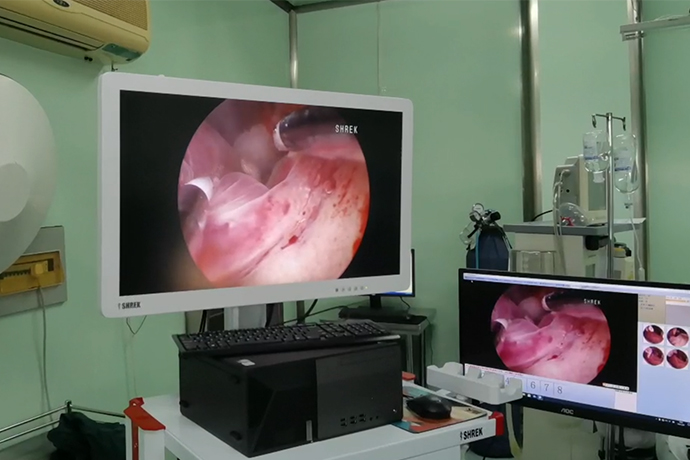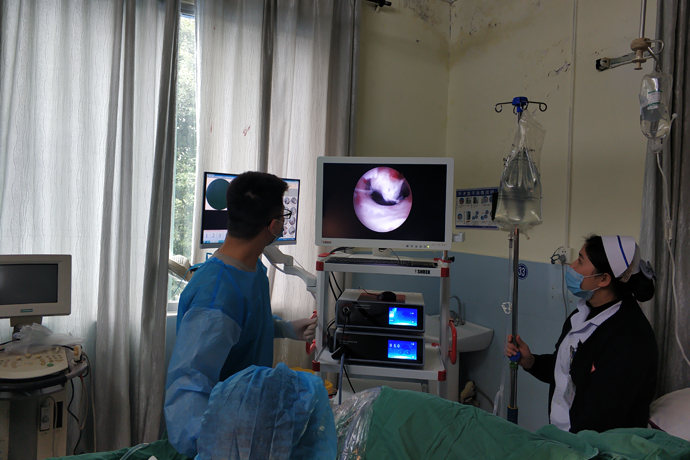【Hysteroscopy】Misunderstandings about Hysteroscopy Surgery
Release time: 09 Mar 2021 Author:Shrek
Hysteroscopic surgery is performed through the natural cavity. It has the advantages of clear vision, high recognition of lesions, less trauma, quick postoperative recovery, and day-to-day surgery. It is popular in hospitals at all levels. Especially in the field of assisted reproduction in infertility, hysteroscopy or surgery has almost become a hurdle that patients must face: intrauterine adhesions, oligomenorrhea, heavy menstruation, menstrual disorders, thin endometrium, thick endometrium, and endometrium. Membranous polyps, endometrial tuberculosis, submucosal fibroids, uterine septum, saddle uterus, unicornuate uterus, bicornuate uterus, birth control ring incarceration, ART failure, recurrent miscarriage, etc., are all coming to us. Hysteroscopy has become the last hurdle to solve the problem, and a small number of doctors and most patients have high hopes. Although hysteroscopy is both a diagnostic method and a treatment method, it plays an important role in the diagnosis and treatment of infertility patients, but patients' friends have some misunderstandings about this.

Misunderstanding 1
Hysteroscopic sub-adhesion surgery will not recur and does not need to be re-examined.
Uterine adhesions are almost a stubborn disease of infertility, and the recurrence rate is high after surgery. There is almost no specific and effective measure to prevent the recurrence of adhesions: drugs, contraceptive rings, balloons, anti-adhesives, amniotic membranes, stem cells, etc. The more methods you use, the more entanglements you have, and the effect can be imagined.
Hysteroscopy is the only effective way to determine whether there is a recurrence after hysteroscopic sub-adhesion. Therefore, after hysteroscopic sub-adhesion, hysteroscopy may be required in the near future. Most patients will be better, and a few will be better. The worse, even amenorrhea, this is related to the severity of intrauterine adhesions and the amount of residual endometrium. There is no upper limit for the number of hysteroscopy reviews.
Misunderstanding 2
B-ultrasound diagnosis, hysteroscopy diagnosis and pathological diagnosis are inconsistent, which link is misdiagnosed.
The principles, equipment, operators, sensitivity and specificity of these three diagnostic methods are different, and they cannot be completely the same.
B-ultrasound found no abnormalities, and lesions, such as inflammation, polyps, and masses were often seen under hysteroscopy; no abnormalities were found under hysteroscopy, and pathological examinations showed inflammatory cell infiltration, polyps, tuberculosis, etc.
Hysteroscopy should be performed for abnormal uterine bleeding, abnormal uterine cavity detected by B-ultrasound, ART failure, unexplained infertility, and recurrent miscarriage. Some reproductive centers have adopted hysteroscopy as a routine examination item before ART, and the purpose is affirmative It is to find the cause of infertility and improve the success rate of trial pregnancy or ART.
Misunderstanding 3
Hysteroscopy can damage the inner lining, causing the inner lining to become thinner, shorter, and less menstrual flow.
Hysteroscopy or surgery is performed under direct vision and is limited to the operation of the endometrium. The impact on the endometrium is far less than that of abortion, uterine evacuation, and curettage. Even if the cutting operation, the doctor will use the least damage linear incision, or cold knife incision, will not damage the intima, and it has nothing to do with the intima thinning, the intima is not long, and the menstrual flow decreases.
Menstruation may be disordered in the short term after hysteroscopy. There are many reasons. Generally, it returns to normal after 1 to 2 cycles. Hysteroscopy can also scratch and stimulate the endometrium, which is conducive to embryo implantation. The occurrence of the above phenomenon may be related to lowering drugs, contraceptives, aging, ovarian function, B time-out machine and measurement errors, accidental or psychological factors, etc.
Misunderstanding 4
Unsuccessful conception after the operation indicates that the hysteroscope has no effect.
Some women undergo hysteroscopy because of prolonged infertility, and some women even use hysteroscopy to help them get pregnant. Therefore, many infertile women regard hysteroscopy as the last straw, thinking that they must be checked after the examination. Being able to conceive oneself without knowing that pregnancy is a more complicated process. It requires a combination of eggs, sperm, and a woman’s physical conditions. It is not a hysteroscopy that can make a woman conceive successfully. Therefore, the failure to become pregnant after the operation is not necessarily a hysteroscopy problem, it may be caused by male sperm problems or female physical fitness.


Misunderstanding 1
Hysteroscopic sub-adhesion surgery will not recur and does not need to be re-examined.
Uterine adhesions are almost a stubborn disease of infertility, and the recurrence rate is high after surgery. There is almost no specific and effective measure to prevent the recurrence of adhesions: drugs, contraceptive rings, balloons, anti-adhesives, amniotic membranes, stem cells, etc. The more methods you use, the more entanglements you have, and the effect can be imagined.
Hysteroscopy is the only effective way to determine whether there is a recurrence after hysteroscopic sub-adhesion. Therefore, after hysteroscopic sub-adhesion, hysteroscopy may be required in the near future. Most patients will be better, and a few will be better. The worse, even amenorrhea, this is related to the severity of intrauterine adhesions and the amount of residual endometrium. There is no upper limit for the number of hysteroscopy reviews.
Misunderstanding 2
B-ultrasound diagnosis, hysteroscopy diagnosis and pathological diagnosis are inconsistent, which link is misdiagnosed.
The principles, equipment, operators, sensitivity and specificity of these three diagnostic methods are different, and they cannot be completely the same.
B-ultrasound found no abnormalities, and lesions, such as inflammation, polyps, and masses were often seen under hysteroscopy; no abnormalities were found under hysteroscopy, and pathological examinations showed inflammatory cell infiltration, polyps, tuberculosis, etc.
Hysteroscopy should be performed for abnormal uterine bleeding, abnormal uterine cavity detected by B-ultrasound, ART failure, unexplained infertility, and recurrent miscarriage. Some reproductive centers have adopted hysteroscopy as a routine examination item before ART, and the purpose is affirmative It is to find the cause of infertility and improve the success rate of trial pregnancy or ART.
Misunderstanding 3
Hysteroscopy can damage the inner lining, causing the inner lining to become thinner, shorter, and less menstrual flow.
Hysteroscopy or surgery is performed under direct vision and is limited to the operation of the endometrium. The impact on the endometrium is far less than that of abortion, uterine evacuation, and curettage. Even if the cutting operation, the doctor will use the least damage linear incision, or cold knife incision, will not damage the intima, and it has nothing to do with the intima thinning, the intima is not long, and the menstrual flow decreases.
Menstruation may be disordered in the short term after hysteroscopy. There are many reasons. Generally, it returns to normal after 1 to 2 cycles. Hysteroscopy can also scratch and stimulate the endometrium, which is conducive to embryo implantation. The occurrence of the above phenomenon may be related to lowering drugs, contraceptives, aging, ovarian function, B time-out machine and measurement errors, accidental or psychological factors, etc.
Misunderstanding 4
Unsuccessful conception after the operation indicates that the hysteroscope has no effect.
Some women undergo hysteroscopy because of prolonged infertility, and some women even use hysteroscopy to help them get pregnant. Therefore, many infertile women regard hysteroscopy as the last straw, thinking that they must be checked after the examination. Being able to conceive oneself without knowing that pregnancy is a more complicated process. It requires a combination of eggs, sperm, and a woman’s physical conditions. It is not a hysteroscopy that can make a woman conceive successfully. Therefore, the failure to become pregnant after the operation is not necessarily a hysteroscopy problem, it may be caused by male sperm problems or female physical fitness.

- Recommended news
- 【General Surgery Laparoscopy】Cholecystectomy
- Surgery Steps of Hysteroscopy for Intrauterine Adhesion
- [Gynecological Hysteroscopy] Techniques for Preventing and Treating Complications of Hysteroscopic Surgery
- [Gynecological Hysteroscopy] Hysteroscopic Adhesiolysis
- [Gynecological Hysteroscopy] IUD Removal under Hysteroscopy